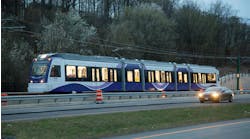A preliminary rail car replacement study of the Greater Cleveland Regional Transit Authority's (GCRTA) has determined the entire fleet is beyond its useful life and should be replaced within 10 years.
The study was conducted by LTK Engineering and found the current fleet is beyond any benefits of continued system upgrades. The study recommends the heavy rail fleet should be replaced within five years and the light-rail fleet within 10 years.
While both fleets have had some level of mid-life rehabilitation, each fleet is exceeding the acceptable 30-year useful life for rail cars in their respective categories, LTK officials said.
“[GC]RTA’s rail system is safe, but we are well past the point of incurring the ever-increasing costs of continually upgrading the fleet and repairing the rail cars. Those costs far exceed that of purchasing a new fleet,” said GCRTA Interim CEO and General Manager, Floun’say Caver. “Our customers will appreciate the reliability, not to mention the style, of riding in new rail cars. This rail system is way over-due in serving our region with state-of-the-art technology and a 21st century rail fleet."
GCRTA contracted with LTK in June of 2018 with a scope of work to determine the estimated remaining life of each fleet and evaluate the benefits of a major rehabilitation of the fleet vs. replacing the rail cars. The study notes the structural loss from corrosion, lack of readily available spare parts and the cost of rehabilitation that exceeps replacement costs as rationale for its recommendation that the entire fleet be replaced.
The study recommends the procurement of two different fleets, heavy rail vehicles and light rail vehicles, rather than a single, common car to serve both high and low platforms. A single, common car fleet would require significant infrastructure work at rail stations, increase engineering design costs, as well as eliminate the ability to phase into service, vehicle purchase and delivery.
LTK recommends that procurement for HRVs begins in 2020, with delivery in 2023, with a recommended fleet size of 34 rail cars. Cost is estimated at $3 million per vehicle, or $102 million.
The reduction in the number of rail cars from its current 40 active to 34 is possible because of greater reliability and fewer maintenance requirements. The number of LRV rail cars can be reduced to 24, from its current 34 active to 24, for the same reasons, LTK says.
LTK also recommends that the procurement of LRVs should start in 2025, with delivery in 2028. Estimated cost is $4 million per vehicle, or $96 million.

Mischa Wanek-Libman | Group Editorial Director
Mischa Wanek-Libman is director of communications with Transdev North America. She has more than 20 years of experience working in the transportation industry covering construction projects, engineering challenges, transit and rail operations and best practices.
Wanek-Libman has held top editorial positions at freight rail and public transportation business-to-business publications including as editor-in-chief and editorial director of Mass Transit from 2018-2024. She has been recognized for editorial excellence through her individual work, as well as for collaborative content.
She is an active member of the American Public Transportation Association's Marketing and Communications Committee and served 14 years as a Board Observer on the National Railroad Construction and Maintenance Association (NRC) Board of Directors.
She is a graduate of Drake University in Des Moines, Iowa, where she earned a Bachelor of Arts degree in Journalism and Mass Communication.

